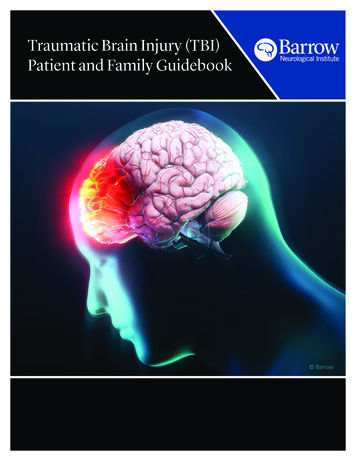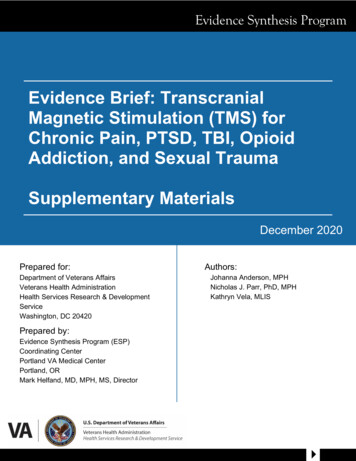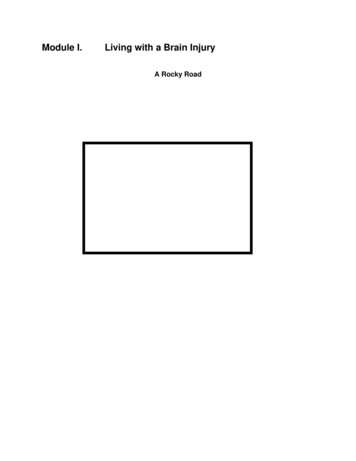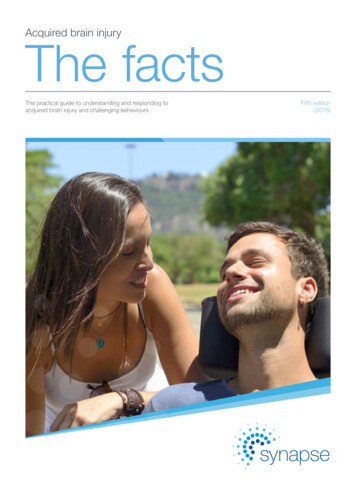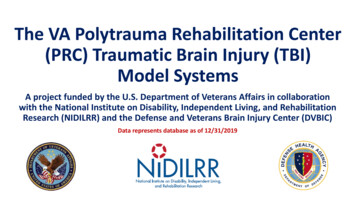
Transcription
TRAUMATIC BRAIN INJURY DEFENSE,VERSION 3 CUTTING EDGE DEVELOPMENTSIN TBI LAW AND SCIENCEJeffrey A. Brown, M.D., Esq., NeuropsychiatryDavid M. Mahalick, Ph.D, ABPN, NeuropsychologyWilliam N. DeVito, Esq., The Law Offices of Leon R. KowalskiCLE Materials - Table of ContentsThese materials may be viewed or downloaded at the “CLE Materials” pageof DANYs website: Course Agenda ------------------------pages 2 - 3Treatise Excerpts: From Litigating Brain Injuries -----------------------------by B. Stern and J. Brownpages 4 - 72 Materials under copyright by West, a Thomson Reuters BusinessReprinted by PermissionOutline: Understanding Traumatic Brain Injury ------------------------------by David M. Mahalick, Ph.D, ABPNpages 73 - 78White v. Deere & Company ----------pages 79 - 83Ali v. Connick --------------------------pages 84 - 94Andrew v. Patterson Motor Freight, Inc. --------------------------------------------pages 95 - 102Ruppel v. Kucanin --------------------- pages 103 - 117Lamasa v. Bachman ------------------- pages 118 - 126Zawaski v. Gigs, LLC ----------------- pages 127 - 133Lugo v. New York City Health and Hospitals Corp. ------------------------------- pages 134 - 147Curriculum Vitae: Jeffrey A. Brown, M.D., Esq. ------------------------------ pages 148 - 187Curriculum Vitae: David M. Mahalick, Ph.D, ABPN ------------------------- pages 188 - 201Curriculum Vitae: William N. DeVito, Esq. ------------------------------------ pages 202 - 203
Course Agenda - Traumatic Brain Injury Defense, Version 3Co- Presenters: Jeffrey A. Brown, MD, JD, David Mahalick, PhD and William DeVito, Esq.September 22, 2016 at 5:30 pm.1. Introduction - DeVito – 10 minutes- Why talk about brain injury cases- Increasing financial stakes in brain injury claims (dollar values)- New Science- Resilience, Reliability and Recovery- How is plaintiff going to present the case and tests that come up- New cases on Diffusion Tensor Imaging- People Recover - the case of Bob Woodruff2. Using the Latest Science and Understanding of Brain Injuries to Help You WorkConstructively with Your Adversary to Settle Cases-Dr. Brown - 30 minutesThe difference between head and brain injuriesThe Hidden Power of Negative DTI StudiesThe Impact of the new DSM-5Motivating Plaintiffs and their lawyers to want to get betterUsing the neuroscience of ResilienceThe Use of Vocational Rehabilitation and ADA Accommodations to acceleraterecoveryThe importance of giving TBI patients hope of recoveryB.-Dr. Mahalick - 30 minutesTypes of Brain InjuriesWhat to look for in Medical RecordsIdentifying TBIClinical Testing by a neuro-psychologistFraming the degree of alleged damageCo-occurring psychiatric disordersTreatmentA.-10 minute break
3. Translating the neuroscience into winning legal strategies – DeVito - 25 minutes- The Ideal Plaintiff case – what you may face- Using discovery to find out what baseline you started with – what brain were youdealing with before the accident- New Cases on the admissibility of diagnostic exams for TBI:White v Deere and Ali v Connick- Review of Past cases on Admissibility of DTI and other tests “the greatest hits”- Using sensitivity and specificity arguments to win the case4. Finale - Q&A – panel discussion – 15 minutes open discussion
1VOLUME 2PART II.BRAIN INJURY LITIGATION FROM A NEUROPSYCHIATRIST’SPERSPECTIVEChapter 11.Avoiding Predictable Case Blunders§11:14.10Catastrophic reliance on “mind/body dualism” [New]The editors believe that there is not one single living physician (exceptsome afflicted with cognitive damage of their own(!) truism, for many decadesit has been indisputable that the brain is intertwined both with the “mind” or“psyche” as well as with the rest of the physical body.Even in healthy, non-brain damaged brains, it is indisputable that brainimpulses travel from pain receptors through nerves well within the spinal cordand ultimately to the thalamic region of the brain. It is equally well-known – withall the above concepts frankly subject in the editor’s view to judicial noticegiven the universality of their being accepted in all fields of medicine – that thebrain in turn sends down via the sympathetic and parasympathetic nervoussystems nerves that influence everything from speed of digestion to heartspeeding up or slowing down in rate and rhythm, with virtually every area of the
2body sending nervous impulses to and in turn receiving nervous impulses fromthe brain in even healthy individuals. 1It is equally indisputable in modern times and again in the editors’ viewworth of judicial notice that even in healthy non-brain-damaged epituitarygland,thehypothalamus, and end organ receptors that are responsible for, for example,ovulation and timing of same in women, body temperature regulation andmetabolism, the “flight or fight” responses of every human being to potentialdanger, etc., etc.It is further well known since the time of Aristotle in the 4th century BCE andin specific research going back to the 1950’s, that even one’s response to asystemic bodily disease like tuberculosis 2 has been known to demonstrate eventhe type of response one gets to an infectious disease like tuberculosis in turn is adependent on the effects of stress and the suppression of the immune system bystress.The March, 2016 issue of The Journal of Clinical Psychiatry explodes anddiscredits any vestiges of any distinction between “psychological” andSee, i.e., Truex and Carpenter, Human Neuroanatomy, Sixth Edition (Baltimore: Williams & WilkinsCompany, 1969); see also Kasper, et al, Harrison’s Principles of Internal Medicine, 19th Edition(New York: McGraw Hill, 2016) at 2708-2725.2 See, e.g., Lerner, Can stress cause disease? Revisiting the tuberculosis research of ThomasHolmes, 1949-1961, 124(7) Ann Intermed, 673-680 (1966).1
3“emotional” causes and injuries on one hand and the relationship to the rest ofthe body on the other.Note specifically the following:1.The article by Coccaro, et al describing a protozoan parasite, Toxoplasmagondii infection and its “relationship with aggression in psychiatricsubjects.” 3The results of the study were that infection with this parasite was infact associated with both higher behavioral aggression and impulsivityespecially with regard to aggression.Their findings “were not accounted for by the presence of othersyndromal/personality disorders or by states or traits related to depressedor anxious moods.”The authors concluded that the data were consistent with those ofprevious studies that indeed suggested a relationship between infectionwith this agent and even suicidal behavior and “further add to thebiological complexity of impulsive aggression both from a categoricaland dimensional perspective.”4Coccaro, et al, Toxoplasma gondii infection: relationship with aggression in psychiatric subjects,77(3), The Journal of Clinical Psychiatry, 334-341 (2016).4 Coccaro, et al, Toxoplasma gondii infection: relationship with aggression in psychiatric subjects,77(3), The Journal of Clinical Psychiatry, (2016) at 341.3
42.An online article that had a title which is self-explanatory: “The clinicalpicture of Alzheimer’s disease in the decade before a diagnosis: clinicaland biomarker trajectories.” 53.Finally, an article clearly indicating that PTSD – often taken by manypsychologists and plaintiff attorneys as indicating “pure” psychologicalproblems or by a defense attorney as indicating a lack of organicproblems again is a false distinction since the article documents that“PTSD symptoms lead to modifications in the memory of the trauma.” 6It also is known that the central nervous system has a direct effect on theorgans in which circulating lymphocytes 7 (including T-cells and cells nowbelieved to be made by the body to combat cancer) 8 directly affected by CNSeffects on the organs and producing these lymphocytes (the bone marrow,thymus, spleen and lymph nodes).Furthermore, and again even in non-brain-damaged individuals andindividuals not warranting a psychiatric diagnosis, it is indisputable that stress is5Ritchie,et al, The clinical picture of Alzheimer’s disease in the decade before diagnosis: clinicaland biomarker trajectories, 77(3), The Journal of Clinical Psychiatry online, 2016.6 Dekel, et al, PTSD symptoms lead to modifications in the memory of the trauma, 77(3), TheJournal of clinical Psychiatry online, 2016.7 See also, Boomershine, et al, Stress and the pathogenesis of tuberculosis, 22, Clin MicrobiolNews 177-181 (2000) and Ishigami, The influence of psychic acts of the progress of pulmonarytuberculosis, 2 Ann Rev Tuberc, 470-485 (1919), and Lewis, et al, Early cell deprivation and nonhuman primates: long-term effects on survival and cell-mediated immunity, 47, Soc. of BiologicPsychiatry, 114-126 (2000), Selyi, Recent progress of stress research, with reference totuberculosis, in: Sparer (Ed.), Personality, stress and tuberculosis (New York: Int. Univ. Press; 1956)at 45-64.8 See, e.g., Pollack, Setting body’s ‘serial killers’ loose on cancer, The New York Times at A1, A3,A13 (8/2/16).
5known to worsen the diverse range of neurological conditions – conditionswhich can be comorbid with traumatic brain injury in many cases.These include Multiple Sclerosis, Tourette’s syndrome, and others.In cases of traumatic brain injury and “mind/body”/“psyche” dualismbecomes even more absurd than it does in non-brain injured people becauseall of the known physical/“somatic” as well as “emotional”/”psychological”direct and indirect consequences of traumatic brain injury.All have been documented for years and not just in specific texts oftraumatic brain injury (e.g., by Silver, et al)9 is the fact that traumatic brain injuryis well-known in many individual to create a host of specific problems includingimbalance, vestibular dysfunction in the head as well as chronic pain orfibromyalgia, and even mask cell (part of our cellular immune responsethroughout the body) dysregulation as well as psychiatric and familydisturbances.The Adams and Victors Principles of Neurology 10 text clearly andindisputably links traumatic brain injury to a host of “physical” and “emotional”psychological manifestations ranging from motor paralysis to tremor to gaitdisturbances to again pain in the back and neck, disturbances of hrespiration,psychiatricSilver, et al (Eds.), Textbook of Traumatic Brain Insjury, 2nd Edition (Washington, DC: AmericanPsychiatic Publishing, Inc.) 2011.10 Ropper, et al (Eds.), Adams and Victors Principles of Neurology, 10th Edition (New York, NY:McGraw Hill, 2011).9
6disorders, and even (in cases of severe brain injury) an autonomic dysfunction“storm” syndrome.The physical as well as “psychologic”/neurobehavioral consequencesand direct results of traumatic brain injury also are discussed in Merritt’sNeurology 11 which links traumatic brain injury to conditions including depressionand anemia.Then if one turns to a traditional classic medical text, e.g., Harrison’sPrinciplesofInternalMedicine /body” interfaces throughout the book, including there beingspecific references to stress in septic shock, stress ulcers, as well as in cleardiscussion of the hypothalamic-pituitary-adrenal axis 13, the hypothalamicpituitary-gonadal axis 14 and the hypothalamic-pituitary-testes axis 15 as well asspecific discussion of metabolic abnormalities including hypokalemia16 (lowpotassium in the blood) and hyponatremia17 (low sodium in the blood) fromtraumatic brain injury – with it being known of course that blood electrolyte11Louis,et al (Eds.), Merritt’s Neurology, 13th Edition (Philadelphia: Wolters Kluwer) 2016.Kasper, et al (Eds.), Harrison’s Principles of Internal Medicine, 19th Edition (New York: McGrawHill) 2015.13 Kasper, et al (Eds.), Harrison’s Principles of Internal Medicine, 19th Edition (New York: McGrawHill) 2015 at 2310.14 Kasper, et al (Eds.), Harrison’s Principles of Internal Medicine, 19th Edition (New York: McGrawHill) 2015 at 335.15 Kasper, et al (Eds.), Harrison’s Principles of Internal Medicine, 19th Edition (New York: McGrawHill) 2015 at 2358.16 Kasper, et al (Eds.), Harrison’s Principles of Internal Medicine, 19th Edition (New York: McGrawHill) 2015 at 305.17 Kasper, et al (Eds.), Harrison’s Principles of Internal Medicine, 19th Edition (New York: McGrawHill) 2015 at 299.12
7abnormalities create neurobehavioral disturbances for the simple reason thatblood goes everywhere in the body, including the brain .Moreover, and “hot off the presses” was an important article describingand specifically “exploring the connection between diabetes and depression” 18that blows a gigantic hole in any anachronistic vestigial claims that a“psyche”/“mind/body” split has any clinical or legal validity whatsoever.The article clearly further discredits further any “mind/body” dichotomywith the statements that:1.“The relationship between diabetes and depression have beenknown for a long time. Each one is a risk factor for the other, andtogether and separately they are a risk factor for dementia”(emphasis added). 192.Although “certainly, many people’s roots to depression anddiabetes are just that, psychological reactions to having the otherdisease” but research shows that the physiological relationshipbetween the two is much deeper.” 203.“A prospective study of 2,525 patient showed that those withdepression and metabolic risk factors were more than six timesHarris, Weight issues: exploring the connection between diabetes, depression, 40(7) ClinicalPsychiatry News (July, 2016) at 5.19 Harris, Weight issues: exploring the connection between diabetes, depression, 40(7) ClinicalPsychiatry News (July, 2016) at 5.20 Harris, Weight issues: exploring the connection between diabetes, depression, 40(7) ClinicalPsychiatry News (July, 2016) at 5.18
8more likely to develop diabetes than patients who had depressionalone, metabolic risk factors alone, are neither” (emphasisadded). 21Indeed, the entire history of the field of “psychosomatic medicine” is oneof course of exploring and researching “mind/body”/“psyche” relationships aswell as demonstrating the absurdity of any false distinction between emotionsand “mind” on one hand and physiological and neuroanatomical changesbetween the brain and the rest of the body on the other.Consider an article on this very same July, 2016 issue of Clinical PsychiatryNews: “Psychosomatic medicine – targeting vagal activity could improve breastcancer survival.”22Here there again was a clear “mind/body” clinically significantinterchange, with the specific finding being that “vagal [nerve] activity predictssurvival in patients with metastatic or recurrent breast cancer” (emphasisadded). 23Amongst the most important recent explosions of the “mind/body” mythand corrolary emphasis of “mind/body” interactions and “comorbidities” was anHarris, Weighty issues: exploring the connection between diabetes, depression, 40(7) ClinicalPsychiatry News (July, 2016) at 5.22Worcester, Psychosomatic medicine – targeting vagal activity could improve breast cancersurvival, presented at the annual meeting of the American Psychiatric Association, 44(7) ClinicalPsychiatry News (July, 2016) at 35.23 Worcester, Psychosomatic medicine – targeting vagal activity could improve breast cancersurvival, presented at the annual meeting of the American Psychiatric Association, 44(7) ClinicalPsychiatry News (July, 2016) at 35.21
9article appearing the summer, 2016 issue of The Journal of Neuropsychiatric andClinical Neurosciences. The virtual entirety of this issue exploring – and exploding-- false “mind/body” relationships and false “emotional/brain” anachronisticand now clearly absurd dualisms.Just the titles of some of these articles is revealing:1.“Functional Neuroanatomy and Neurophysiology of FunctionalNeurological Disorders (Conversion Disorder)” which describes“bottom-up limbic influences interacting with and influencing basicmotor function.” 242.“Apathy is Associated with Ventral Striatum Volume in SchizophreniaSpectrum Disorder.” 253.Even“Psychiatric Comorbidities in Restless Leg ��26emotionand“psychological” versus “brain” and “body” has been discredited as well by, e.g.,imaging studies that showed clear neurophysiologic and even neuroanatomicdifferences in individuals suffering from borderline personality disorder versusthose who did not.Voon, et al, Functional neuroanatomy and neurophysiology of functional neurologicaldisorders (conversion disorder), 28(3) The Journal of Neuropsychiatric and Clinical Neurosciences168-190 (2016).25 Roth, et al, Apathy is Associated with Ventral Striatum Volume in Schizophrenia SpectrumDisorder, 28(3) The Journal of Neuropsychiatric and Clinical Neurosciences 191-194 (2016).26 Kallweit, et al, Psychiatric comorbidities in restless legs syndrome, 28(3) The Journal ofNeuropsychiatric and Clinical Neurosciences 239-242 (2016).24
10Regarding traumatic brain injury in particular, The New England Journal ofMedicine 7/14/16 issue devoted an article to other things including collectingblood samples for genetic and protein analysis “of veterans who have hadtraumatic brain injury,” as well as the falseness of distinguishing betweentraumatic brain injury “as a physical injury.”The authors instead consider “PTSD as a psychiatric condition” when “thesymptoms overlap, and the diagnoses coexist in many of these veterans” with“treating one often” alleviating symptoms “ascribed to the other” (emphasisadded). 27Furthermore, in the prior 7/7/16 issue of this journal, there had beenspecific reference to a “cutting edge” technology that goes way beyond issuesrelated to traumatic brain injury but indeed provides perhaps the newest linkweaving an inextricably intertwining web between the “brain,” the “mind,”emotions and the rest of the body.Indeed here, biomarkers – the forefront of “unlocking precision medicine”throughout the body were linked to “genomic” – inherited – information thatholds promise in fact “in selecting therapy that improves clinical care” despitethe (Daubert-type) barriers to these being routinely used clinically, let alone inlitigation because “potentially useful tests have not been adapted into clinicalOkie, TBI’s long-term follow-up, slow progress in science and recovery, 375(2) The New EnglandJournal of Medicine 180-184 (2016).27
11practice rapidly, in part because we lack common evidentiary standings forregulatory, clinical, coverage, and reimbursement decisions.Furthermore, clinical implication will require the consistent collection andsharing of data on biomarker tests, treatments, and patient outcomes. 28Lyman, et al, Biomarker test for molecularly targeted therapies – the key to unlocking precisionmedicine, 375(1) The New England Journal of Medicine, 4-6 (2016).28
12§11:14.20Critical “mind/psyche/body” issues regarding the accuracy,validity, and reliability of retroactive recollection of thetraumatic eventOne of the first things that one of the editors (JB) learned during his firstday of medical school in 1963 was that it is essential to indicate in any medicalrecord to what extent the patient giving “his or her” story – the “history” – is anaccurate factual historian whose recollections, perceptions, and claims of pastevents should or should not be taken as gospel truth.The ability of an interviewee to give an accurate history often is includedby one or more of the following events, even in individuals warranting any “braininjury and/or formal psychiatric diagnosis but even in completely “normal”individuals. The history-contaminating factors are known by any sophisticatedphysician to range from simple pride to desires for attention and sympathy (partof “secondary gain”) to the psychological reasons to misperceive a problem asbeing physical as opposed to “mental” (“primary” gain) to pressure fromparents (particularly in child custody disputes) to conscious and/or unconsciousdesires to create a picture of “damages” for litigation purposes beyond thatwhich is truly objectively justified.This accuracy has two elements:validity (the history reflecting whatactually occurred) on one hand and “reliability” (the ability of the same historyto be given consistently over time).
13One of the most striking experiences this examiner had during his first weekof medical school and during the years thereafter when he has taught clinicalinterviewing in virtually all areas of medicine, not just psychiatry, was how apatient’s history – recollection – relating of claimed events dramatically can andhas changed, even from week to another – and even when there is no litigationinvolved.It indeed is for that reason that this examiner still when he teaches secondyear medical students about clinical interviewing always tries to have thestudents re-interview patients if they are in the hospital for more than one weeksince the histories given so often and so dramatically change.One of the more dramatic experiences one of the editors (JB) had waswhen he interviewed a four year old child after having been appointed by aFamily Court judge to help resolve a child custody dispute. There was nothingphysically, psychiatrically, or in any “brain damaged” diagnostic way anythingwrong with this four year old girl.Then, when this examiner took her history, she spontaneously exclaimedthat, “My daddy is a menace to society!” She in fact was quite empathic onthat point and spontaneously repeated that sentence at least three timesduring the interview.Then when this examiner asked her what the word “menace” meant, shehad shrugged her shoulders, smiled and had said, “I don’t know.”
14Then when he asked her what the word “society” meant she actuallylaughed and said “I don’t know!”When this examiner finally asked her then why she said that sentence tohim, this completely otherwise “normal” child smiled again and said, “Well, Idon’t know, my mommy told me to tell you that!”The importance of investigating the reliability and validity of a patient’s“story” even in otherwise “normal” individuals not only requires investigation ofany “external” influences and motivations that could influence the historian’sreports but is particularly important even in those not formally diagnosed with“brain” and/or “psychiatric” problems, when complaints made that are at issuein a lawsuit are largely subjective.These latter complaints, which clearlyinvolved “mind/body” interactions rather than a “one or the other” approachrange from subjective symptoms and complaints including headaches, somaticpain, complaints of sensory loss, and many others that require behavioralmedicine investigation even when a plaintiff and/or attorney formally drops anyand all “mental” and/or “psychiatric” claims of injury.Again, the entire modern field of pain medicine, “psychosomatic”medicine, and what DSM-5 characterizes as “Somatic Symptom titiousDisorder,” “Other Specific Somatic Symptoms and Related Disorders,” and
15“Unspecified Somatic Symptom and Related Disorder 29 all involve recognitionthat one simply cannot artificially separate “mental” and “psychiatric”perceptions, misperceptions, claims and true dysfunction in an artificial“mind/body” dichotomy.The absurdity of having any artificial “mind/body” dichotomy andignoring not only how motivation affects history accuracy in even “healthy”people making no “psychiatric” damages claims on one hand as well as theabsurdity of ignoring the reality that the nervous system itself literally inextricablyties together the “brain” with the “rest of the body” is demonstrated throughDSM-5, with one example being the conditions required for “FunctionalNeurological Symptom Disorder” of which there are eight different subtypes(with their International Classification of Diseases Codes):1.“(F44.4) With weakness or ,tremor,dystonicmovement, myoclonus, gait disorder);3.“(F44.4) With swallowing problems”;4.“(F44.4) With speech symptom (e.g., dysphonia, slurre4d speech)”;5.“(F44.5) With attacks or seizures”;American Psychiatric Association, Desk Reference to the Diagnostic Criteria from DSM-5(Washington, DC: American Psychiatric Publishing 161-167 (2015).29
166.“(F44.6) With anesthesia or sensory loss”;7.“(F44.6) With special sensory symptoms (e.g., visual, olfactory orhearing disturbance); and8.“(F44.7) With mixed symptoms.”Note then that further that physicians of all specialties – including thosewho are not dealing with presentations of “psychiatric” or “psychological”disturbance but instead of “physical” problems ranging from paralysis toweakness to tremors to seizures and sensory loss must be familiar with thepsychiatric Diagnostic Manual and all of the “mind/body” relationships clearlyset forth therein. PRACTICE NOTE:Any attempt to “plead away” issues related to thefactual accuracy of a historian and the corollary need to have behavioralmedicine expertise in investigating this as well as any attempt by anyattorney – or judge – to ignore the reality of the fact that the mind andthe body are inextricably intertwined and that behavioral medicineexpertise is required to determine the interrelationship between physicalcomplaints and mental state/motivation even in individuals making no“pure” psychiatric claim is fraught with the risk of grave mischaracter ofjustice which should lead to appellate findings of reversible error.
17Simply put, clinging to anachronistic notions that there is a“mind/body” choice in pleadings, claims, and testimony risk making theentire trial a travesty clinically and legally.As a consequence of the ignoring of the critical importance ofdetermining history accuracy and including “mind/body” interactions andspecifically the “somatoform” disorder as part of admitted testimony, evenwhen formal “psychiatric” claims are dropped, the result has been all too oftenchaos and confusion for attorneys and jurors alike.Indeed, what happens all too often is that an attorney (on either side)simply has taken what a patient claims as recalled fact as gospel truth andsimply passes that erroneous perception and/or erroneous history on to the nextclinician or lawyer, with there being the same kind of potentially horrific clinicaland legal consequences regarding this “telephone game” as there areunderlying all of the exclusions and exceptions to the “hearsay” rule and thelaw. PRACTICE NOTE: Simply put, repeated witness statements often actuallycontradict themselves, having not only no intrinsic reliability but oftenquite the opposite. One only has to look at the movie “Twelve AngryMen” with Henry Fonda, the movie “Rashomon” and even to the lyrics ofthe song, “Yes, I remember it well” with this point to be driven home.
18Yet all too often physicians commit the grave error that the hearsay ruleprevents attorneys from committing at least in court:blindly repeating andtaken as fact history which has its own inherent unreliability in many cases.The sources of this potential witness and plaintiff factual unreliability areworth repeating since they have been so often ignored by so many over theyears.Again, these range from true memory disturbance resulting fromtraumatic brain injury on one hand to unconscious “hysterical” symptomexaggeration and history distorting behavior fueled not necessarily by litigationbut by classic “secondary gain” needs for sympathy and assistance, toinfections that affect memory (e.g., neurosyphilis, tuberculosis, and HIV, amongstothers), to the cognitive effects of brain tially“psychological” in nature – including posttraumatic stress disorder anddepression – not only have well-known cognitive and memory distorting effectsbut the fact that there are medications that are known to improve cognitivefunctioning (including classically Ritalin and Adderall in some instances andantidepressants in others) further make it imperative for attorneys on both sidesto investigate carefully with the help of neuropsychiatrists as well as objective“collateral” sources of behavioral data (not just friends of the plaintiff but preaccident medical and pharmacy records) to determine to what extent a
19plaintiff patient’s retroactive account of a trauma and its effects can bebelieved by a clinician and attorney, let alone a juror.Ironically, one of the easiest ways for this to be done and in the editor’sexperience assiduously avoided by both plaintiff and defense attorneys is thetaking of serial neuroradiological and electrophysiological studies (CAT scans,MRIs with diffusion tensor imaging, electroencephalograms, and x-rays ofreportedly broken bones).Instead, the usual approach appears to be that all studies that are takenare taken right after the accident – with there being an implied assumption thatthese injuries don’t heal, when there is a tidal wave of material cited in this andother volumes related to the concept of neuroplasticity and resilience. PRACTICE NOTE: As an example, if a person has had intracerebralbleeding at the time of an impact, and if that person is continuingto complain for years about memory and other cognitive problems,it would make sense for there to be an MRI with DTI and/or CATscan and/or EEG (especially a 72 hour video EEG) done within themonths before a trial.That way it could be determined if there is a lesion
injury also are discussed in Merritt’s Neurology. 11. which links traumatic brain injury to conditions including depression and anemia. Then if one turns to a classic medical text, e.g., traditional Harrison’s Principles
